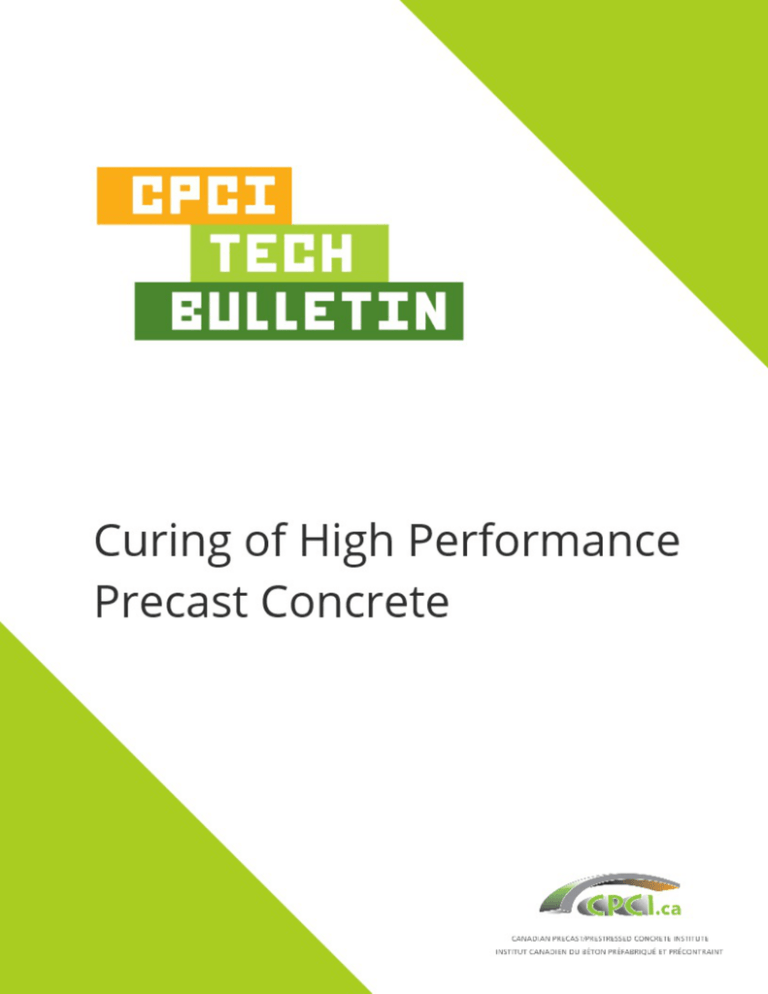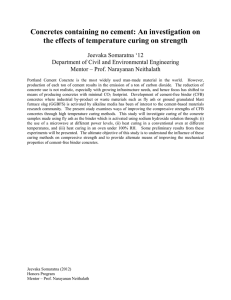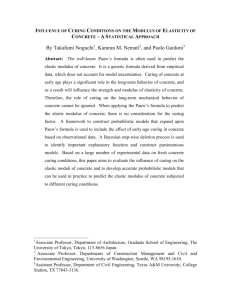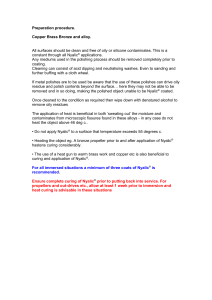Untitled - Canadian Precast Prestressed Concrete Institute
advertisement

Curing of High Performance Precast Concrete Proper curing of concrete is critical to ensuring a product that is strong, watertight, and durable. Curing is the chemical reaction (referred to as hydration) that occurs between the cementitious materials and water, to form a Calcium Silicate Hydrate (CSH) gel, or the “glue” that binds all of the ingredients together. In order to achieve complete hydration, it is imperative that moisture not evaporate from the product, and that the product be in a heated environment. This paper discusses the curing cycle for precast concrete cured in a controlled environments, with special emphasis on: (1) the allowable maximum curing temperature to avoid delayed ettringite formation (DEF) and (2) the duration of curing required for high performance concrete. Background There are essentially three basic curing methods, all of which are designed to keep the concrete product moist: 1. One method is to maintain the presence of mixing water in the product while it hardens. This can be achieved by ponding, fogging or spraying, and wet coverings such as wet burlap. 2. Another method is to minimize moisture loss by utilizing membranes such as forms, canvas or polyweave tarps, or by using curing compounds. 3. One of the most common methods, used at precast plants, is accelerated curing where strength gain is accelerated by the use of live steam, radiant heat or heated beds. The use of commercial accelerating admixtures is also commonly used by some precast manufacturers. Live low-pressure steam curing, in tandem with tarping or covering (See Figure 1) is a common method because it has the advantage of providing the heat necessary to accelerate the hydration process, while also ensuring the retention of moisture in the product. In order to be effective, it is necessary to follow a proper curing cycle. Figure 1: Precast concrete cured in controlled environments Page | 2 A typical accelerated curing cycle consists of four parts: 1. Preset (or Pre-heating) – this is the initial set of the concrete. Preset allows the product a period of time to commence hydration, and is an important part of the cycle. Subjecting the product to higher temperatures before the product has begun hydration can result in thermal shock, and cracking. 2. Ramping – this is the period during which the product is raised from the preset temperature to the curing target temperature, and must be done at a controlled rate of between 10°C to 20°C per hour. The minimum temperature of 10°C/hour is required to rapidly activate the hydration process, while the maximum temperature of 20°C/hour is necessary to prevent thermally shocking the product. 3. Holding Period - the product is held at the target curing temperature (60°C to 70°C) until the desired concrete strength is developed. 4. Cooling Period – the product temperature is cooled prior to handling, or placing outdoors. This is usually the time at which the differential in temperature between the concrete and the ambient outside temperature is less than 20°C. Figure 2: Idealized Accelerated Curing Cycle. In general, the higher the curing temperature, the faster the desired concrete strength is achieved. Precasters typically achieve 28 day strengths at stripping times of 16 hours or less, depending on the concrete mix design. This curing cycle enables them to reuse their forms on a 24 hour cycle. There is a limit, however, on what the maximum temperature can be, to prevent Delayed Ettringite Formation (DEF), and damage to the product. The maximum curing temperature that is generally acknowledged by most authorities is 70°C, for products that are exposed to damp or continuously wet conditions in their service life. Page | 3 Curing Temperatures and Delayed Ettringite Formation During the late 1990s, DEF (a form of internal sulfate attack) was a major concern throughout Europe, especially in relation to the production of structural elements such as girders. Many manufactures were curing their products at very high temperatures in excess of 70°C, and as high as 90°C, in order to "double pour" their sections within a 24 hour period. At the same time, however, the cements contained a relatively high percentage of sulfates. As a result, products that were exposed to a moist environment experienced deleterious cracking, after only a few years. Upon investigation, this was determined to be a result of DEF. Although ettringite is a normal product of early hydration of Portland cement, curing at too high a temperature stops the formation of ettringite during the early hydration process. If the concrete product is later exposed to water, or wet conditions at ambient temperature, ettringite slowly forms and grows in the matrix, leading to a deleterious expansion of the concrete and destructive cracking, known as DEF. In 1996, RILEM (Reunion Internationale des Laboratoires d’Essais et de Recherches sur les Materiaux et les Constructions) established TC-ISA, a technical committee to study field problems, with regards to DEF and cracked concrete1. Frequently, RILEM establishes technical committees (TCs) to investigate specific problems with construction materials. Typically, the TCs have a maximum life span of four years, however, this committee continued its work until they were disbanded in 2002. Consensus was reached that internal sulfate attack had not been an issue until the early 1990s. It was in the 1990s that cement manufacturers increased the sulfate content of clinkers or cements, and increased the fineness of their cements (Blaine surface area) in response to the increased demand for accelerated early strength development. Committee members believed that this, combined with excessively high curing temperatures, was the principal cause of DEF. While some of the researchers believed a maximum curing temperature of 65°C should be recommended, others acknowledged a maximum of 70°C2. Today, a maximum curing temperature of 70°C is commonly accepted around the world3,4,5,6,7,8 while some authorities permit up to 77°C if Supplemental Cementitious Materials, such as Fly Ash, Ground Granulated Blast Furnace Slag, or Silica Fume are added to the concrete or blended into the cement. The American Concrete Institute (ACI)9 defines DEF as a form of sulfate attack by which mature hardened concrete is damaged by internal expansion during exposure to cyclic wetting and drying in service and caused by the late formation of ettringite, not because of excessive sulfate; not likely to occur unless the concrete has been exposed to temperatures during curing of 158°F (70°C) or greater and less likely to occur in concrete made with pozzolan or slag cement. For concrete products exposed to infrequent wetting, and those that are continually dry for their service lives, a maximum curing temperature of 82°C has been shown to be effective in ensuring long-term durability. Page | 4 Effect of Curing Conditions on the Performance of Concrete Although low-pressure live steam curing has been accepted as a standard method of accelerated curing, throughout the world, some specifying agencies require girder manufacturers to “secondary cure” (“wet cure”) for a period of three, five or seven days after having completed steam curing. CPCI is currently conducting research on this approach, specifically for high performance mixes such as CSA C-1 and CSA C-XL, to demonstrate that precast concrete does not require a lengthy secondary cure. Precast concrete is produced under controlled, repeatable conditions indoors. Moreover, steam cured concrete is produced with an initial curing period at temperatures ranging from 60-70°C, which accelerates both the hydration reactions and strength development of the product. In principle, this process is expected to reduce the needed duration of the additional curing. There is, however, currently no differentiation in Canada between the degree of curing needed for concrete products produced by different manufacturing methods. The research will evaluate the properties of plant cast precast concrete relative to the CSA performance requirements. Early results of the research have demonstrated that curing for three days or less will produce concrete that meets the minimum 28 and 56 day strength and rapid chloride permeability requirements. A final report is expected in 2013. The objective of an effective, efficient curing procedure is to enable concrete product manufactures to produce their products quickly, efficiently and economically. Curing at a temperature of 70°C is safe and conservative, and offers the precaster the ability to develop mix designs and curing cycles that result in savings for the producer and more sustainable products that use less cement. CPCI precasters are committed to manufacturing products that are strong, economical and sustainable. References: 1. International RILEM TC 186-ISA Workshop on Internal Sulfate Attack and Delayed Ettringite Formation, 4-6 September 2002, Villars, Switzerland INTERNAL SULFATE ATTACK -POINTS OF AGREEMENT AND DISAGREEMENT Jan Skalny 2. International RILEM TC 186-ISA Workshop on Internal Sulfate Attack and Delayed Ettringite Formation, 4-6 September 2002, Villars, Switzerland Summary of Discussions During Workshop 3. US Department of Transportation, Federal Highway Administration, HPC Bridge Views - Issue 47, Jan/Feb 2008 Thermal Mass Issues in High Performance Concrete, John Gaida, CTL Group, http://www.hpcbridgeviews.com/directory3.asp 4. US Department of Transportation, Federal Highway Administration, HPC Bridge Views - Issue 47, Jan/Feb 2008, Mass Concrete Provisions in Texas, Kevin R. Pruski and Ralph Browne, Texas Department of Transportation, http://www.hpcbridgeviews.com/directory3.asp 5. Center for Transportation Research The University of Texas at Austin, Preventing Alkali-Silica Reaction and Delayed Ettringite Formation in New Concrete, Project Summary Report 0-4085-S, March 2006, http://www.utexas.edu/research/ctr/pdf_reports/0_4085_S.pdf 6. Portland Cement Association, PCA, Ettringite Formation and the Performance of Concrete, IS417, Portland Cement Association, 2001, http://www.cement.org/tech/faq_DEF.asp Page | 5 7. Florida Department of Transportation, Determination of the Maximum Placement and Curing Temperatures in Mass Concrete to Avoid Durability Problems and DEF, University of Florida 2003 Report, Chinietal.,http://www.dot.state.fl.us/researchcenter/Completed_Proj/Summary_SMO/FDOT_BC354_29_rpta.pdf 8. Cement and Concrete Research 31, 2001, The semiquantitative dertermination and morphology of ettringite in pastes containing expansive agent cured in elevated temperature, Tsinghua University, Beijing 9. American Concrete Institute ACI CT-13, ACI Concrete Terminology, (2013), Farmington Hills, MI, 48331, U.S.A. Acknowledgements: CPCI wishes to thank the contributions to this paper by Mel Marshall, Mel C Marshall Industrial Consultants Inc. DISCLAIMER: Substantial effort has been made to ensure that all data and information in this publication is accurate. The Canadian Precast/Prestressed Concrete Institute cannot accept responsibility of any errors or oversights in the use of material or in the preparation of architectural or engineering plans. The design professional must recognize that no design guide can substitute for experienced engineering and professional judgment. This publication is intended for use by professional personnel competent to evaluate the significance and limitations of its contents and able to accept responsibility for the application of the material it contains. Users are encouraged to offer comments to the Canadian Precast/Prestressed Concrete Institute on the content and suggestions for improvement. Questions concerning the source and derivation of any material in the design guide should be directed to Canadian Precast/Prestressed Concrete Institute. Canadian Precast/Prestressed Conrete Institute 196 Bronson Avenue, Suite 100, Ottawa, ON, K1R 6H4 Tel: (613) 232-2619 Fax: (613) 232-5139 Toll free: 877 937 2724, Email: info@cpci.ca Web site: www.cpci.ca Page | 6


